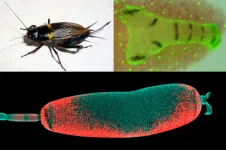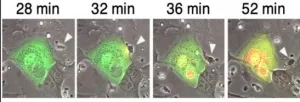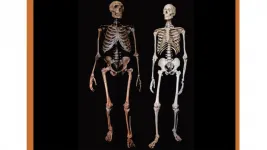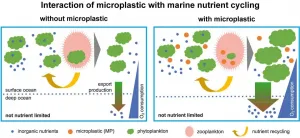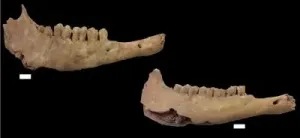(Press-News.org) OAK BROOK, Ill. - An artificial intelligence-driven system that automatically combs through brain MRIs for abnormalities could speed care to those who need it most, according to a study published in Radiology: Artificial Intelligence.
MRI produces detailed images of the brain that help radiologists diagnose various diseases and damage from events like a stroke or head injury. Its increasing use has led to an image overload that presents an urgent need for improved radiologic workflow. Automatic identification of abnormal findings in medical images offers a potential solution, enabling improved patient care and accelerated patient discharge.
"There are an increasing number of MRIs that are performed, not only in the hospital but also for outpatients, so there is a real need to improve radiology workflow," said study co-lead author Romane Gauriau, Ph.D., former machine learning scientist at Massachusetts General Hospital and Brigham and Women's Hospital Center for Clinical Data Science in Boston. "One way of doing that is to automate some of the process and also help the radiologist prioritize the different exams."
Dr. Gauriau, along with co-lead author Bernardo C. Bizzo, M.D., Ph.D., and colleagues, and in partnership with Diagnosticos da America SA (DASA), a medical diagnostics company in Brazil, developed an automated system for classifying brain MRI scans as either "likely normal" or "likely abnormal." The approach relies on a convolutional neural network (CNN), a sophisticated type of AI that allows the model to learn directly from the images.
The researchers trained and validated the algorithm on three large datasets totaling more than 9,000 examinations collected from different institutions on two different continents.
In preliminary testing, the model showed relatively good performance to differentiate likely normal or likely abnormal examinations. Testing on a validation dataset acquired at a different time period and from a different institution than the data used to train the algorithm highlighted the generalization capacity of the model. Such a system could be used as a triage tool, according to Dr. Gauriau, with the potential to improve radiology workflow.
"The problem we are trying to tackle is very, very complex because there are a huge variety of abnormalities on MRI," she said. "We showed that this model is promising enough to start evaluating if it can be used in a clinical environment."
Similar models have been shown to significantly improve turnaround time for the identification of abnormalities in head CTs and chest X-rays. The new model has the potential to further benefit outpatient care by identifying incidental findings. An incidental finding is an abnormality not related to the reason the physician ordered the test.
"Say you fell and hit your head, then went to the hospital and they ordered a brain MRI," Dr. Gauriau said. "This algorithm could detect if you have brain injury from the fall, but it may also detect an unexpected finding such as a brain tumor. Having that ability could really help improve patient care."
The work was the first of its kind to leverage a large and clinically relevant dataset and use full volume MRI data to detect overall brain abnormality. The next steps in the research include evaluating the model's clinical utility and potential value for radiologists. Researchers would also like to develop it beyond the binary outputs of "likely normal" or "likely abnormal."
"This way we could not only have binary results but maybe something to better characterize the types of findings, for instance, if the abnormality is more likely to be related to tumor or to inflammation," Dr. Gauriau said. "It could also be very useful for educational purposes."
Further evaluation is currently ongoing in a controlled clinical environment in Brazil with the research collaborators from DASA.
INFORMATION:
"A Deep Learning-Based Model for Detecting Abnormalities on Brain MRI for Triaging: Preliminary Results from a Multi-Site Experience." Collaborating with Drs. Gauriau and Bizzo were Felipe C. Kitamura, M.D., Ph.D., Osvaldo Landi Junior, M.D., Suely F. Ferraciolli, M.D., Fabiola B. C. Macruz, M.D., Ph.D., Tiago A. Sanchez, Ph.D., Marcio R. T. Garcia, M.D., Leonardo M. Vedolin, M.D., Ph.D., Romeu C. Domingues, M.D., Emerson L. Gasparetto, M.D., Ph.D., and Katherine P. Andriole, Ph.D.
Radiology: Artificial Intelligence is edited by Charles E. Kahn Jr., M.D., M.S., Perelman School of Medicine at the University of Pennsylvania, and owned and published by the Radiological Society of North America, Inc. (https://pubs.rsna.org/journal/ai)
RSNA is an association of radiologists, radiation oncologists, medical physicists and related scientists promoting excellence in patient care and health care delivery through education, research and technologic innovation. The Society is based in Oak Brook, Illinois. (RSNA.org)
For information on brain MRI, visit RadiologyInfo.org.
Certain signalling proteins, which are responsible for the development of innate immune function in almost all animals are also required for the formation of the dorsal-ventral (back-belly) axis in insect embryos. A new study by researchers from the University of Cologne's Institute of Zoology suggests that the relevance of these signalling proteins for insect axis formation has increased independently several times during evolution. For example, the research team found similar evolutionary patterns in the Mediterranean field cricket as in the fruit fly Drosophila, although the two insects are only very distantly related and previous observations suggested different evolutionary ...
Metaplasia is defined as the replacement of a fully differentiated cell type by another. There are several classical examples of metaplasia, one of the most frequent is called Barrett's oesophagus. Barrett's oesophagus is characterized by the replacement of the keratinocytes by columnar cells in the lower oesophagus upon chronic acid reflux. This metaplasia is considered a precancerous lesion that increases by around 50 times the risk of this oesophageal adenocarcinoma. Nonetheless, the mechanisms involved in the development of metaplasia in the oesophagus are still partially unknown.
In a new study published in Cell Stem Cell, researchers led by Mr. Benjamin Beck, ...
Drawing on epidemiological field studies and the FrenchCOVID hospital cohort coordinated by Inserm, teams from the Institut Pasteur, the CNRS and the Vaccine Research Institute (VRI, Inserm/University Paris-Est Créteil) studied the antibodies induced in individuals with asymptomatic or symptomatic SARS-CoV-2 infection. The scientists demonstrated that infection induces polyfunctional antibodies. Beyond neutralization, these antibodies can activate NK (natural killer) cells or the complement system, leading to the destruction of infected cells. Antibody levels are slightly lower in asymptomatic ...
Creativity--the "secret weapon" of Homo sapiens--constituted a major advantage over Neanderthals and played an important role in the survival of the human species. This is the finding of an international team of scientists, led by the University of Granada (UGR), which has identified for the first time a series of 267 genes linked to creativity that differentiate Homo sapiens from Neanderthals.
This important scientific finding, published today in the prestigious journal Molecular Psychiatry (Nature), suggests that it was these genetic differences linked to creativity that enabled Homo sapiens to eventually replace Neanderthals. It was creativity that gave Homo sapiens the ...
Children with weakened immune systems have not shown a higher risk of developing severe COVID-19 infection despite commonly displaying symptoms, a new study suggests.
During a 16-week period which covered the first wave of the pandemic, researchers from Southampton carried out an observational study of nearly 1500 immunocompromised children - defined as requiring annual influenza vaccinations due to underlying conditions or medication. The children, their parents or guardians completed weekly questionnaires to provide information about any symptoms they had experienced, COVID-19 test results and the impact of the pandemic on their daily life.
The results, published in BMJ Open, showed that symptoms of COVID-19 infection were common in many of the children - with ...
The effects of the steadily increasing amount of plastic in the ocean are complex and not yet fully understood. Scientists at GEOMAR Helmholtz Centre for Ocean Research Kiel have now shown for the first time that the uptake of microplastics by zooplankton can have significant effects on the marine ecosystem even at low concentrations. The study, published in the international journal Nature Communications, further indicates that the resulting changes may be responsible for a loss of oxygen in the ocean beyond that caused by global warming.
Plastic debris in the ocean is a widely known problem for large marine mammals, fish and seabirds. These ...
The results, exceptional first time evidence of how early flocks of domesticated sheep fed and reproduced within the Iberian Peninsula, are currently the first example of the modification of sheep's seasonal reproductive rhythms with the aim of adapting them to human needs.
The project includes technical approaches based on stable isotope analysis and dental microwear of animal remains from more than 7,500 years ago found in the Neolithic Chaves cave site in Huesca, in the central Pyrennean region of Spain. The research was coordinated from the Arqueozoology Laboratory of the UAB Department of Antiquity, with the participation of researchers from the University of Zaragoza, the Museum of Natural History of Paris, and the Catalan Institute of Human Palaeocology and Social Evolution (IPHES) ...
Most battery materials, novel catalysts, and storage materials for hydrogen have one thing in common: they have a structure comprised of tiny pores in the nanometer range. These pores provide space which can be occupied by guest atoms, ions, and molecules. As a consequence, the properties of the guest and the host can change dramatically. Understanding the processes inside the pores is crucial to develop innovative energy technologies.
Observing the filling process
So far, it has only been possible to characterise the pore structure of the substrate materials precisely. The exact structure of the adsorbate inside the pores has remained hidden. To probe this, a team from the HZB together with colleagues ...
The natural menopause occurs when the menstrual periods cease due to the naturally decreased ovary function. There is a significant interindividual variation in the age at natural menopause but, on average, women undergo it around the age of 51 in Western countries. Furthermore, the length of the preceding menopausal transition, characterized by irregular menstrual cycles and menopausal symptoms, is also known to vary between individuals.
The study revealed that higher estradiol and follicle-stimulating hormone levels, irregular menstrual cycles, and menopausal symptoms are strong indicators of approaching menopause in middle-aged women. Additionally, information related ...
DALLAS - April 21, 2021 - Food banks should be used more consistently rather than only during emergencies to better address food insecurity and related health issues, a joint study by researchers at UT Southwestern Medical Center and economists at the University of Dallas shows.
"The main discovery in our research is that encouraging clients and making it easier for clients to receive food frequently improves their food security, health, and well-being," says Sandi Pruitt, Ph.D., associate professor of population and data sciences at UT Southwestern, and senior author of the ...

